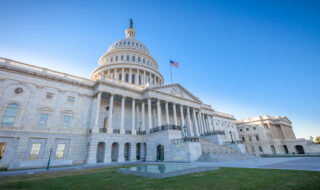January 20, 2022 Last Edit: June 5, 2025
2022 Minnesota Session Preview – Part I
Minnesota lawmakers will return to the State Capitol on January 31 for another year of virtual legislating. This session marks the second year of the two-year legislative cycle. While the budget was resolved in year one, legislators will have plenty to confront this year.
As always, NFIB will be there to support pro-growth solutions and advocate for small businesses in our state.
The partisan balance in each legislative body remains the same going into 2022, albeit with some changes due to developments around individual members:
Minnesota House: 70 Democrats, 64 Republicans
- 4 Republicans formed the New House Republicans in 2019 and caucus separately
- 1 Republican was removed from New House Republicans caucus in 2021 and caucuses independently
- 1 Democrat was removed from House Democratic caucus in 2021 and caucus independently
Minnesota Senate: 34 Republicans, 31 Democrats, 2 Independents
- the independent members caucus with Republicans (Sen. Tom Bakk, D-Cook and Sen. David Tomassoni, D-Chisholm)
Despite the narrow governing majorities in each body, the ideological divide between the two primary caucuses is often wide on major issues. Last session, compromise was hard to come by as Governor Walz and the Legislature took an extra six weeks to reach a budget deal.
Here’s a look at some key themes that will shape the 2022 Minnesota Legislative Session:
New Leadership: In September 2021, the Republican and Democratic Caucuses elected new leaders. Senator Jeremy Miller (R-Winona) is the new Majority Leader. In this role, Miller serves as the floor leader, chair of the Rules Committee, and primary face of the caucus. Miller has served in the Minnesota Senate since 2011, and previously served as Senate President. He lives in Winona with his wife and children, where he serves as CFO for Wm. Miller Scrap Iron & Metal Co. His experience as a small business leader will serve him well in the new role.
Miller succeeds Sen. Paul Gazelka (R-East Gull Lake), who served as Majority Leader since 2017 and stepped down in advance of launching a run for governor. As Majority Leader, Sen. Gazelka was instrumental in many small business victories over the years, including a reduction in small business taxes, stabilizing the individual health insurance market and blocking harmful regulations and mandates. NFIB thanks Sen. Gazelka for his years of service.
Senator David Osmek (R-Mound) will succeed Miller as Senate President. First elected in 2012, Osmek has served as a committee chair and been a critical voice for small businesses during his tenure. As President, Osmek is the presiding officer during meetings of the Minnesota Senate.
Senator Melisa Lopez Franzen (D-Edina), takes over as Minority Leader from retiring Senator Susan Kent (D-Woodbury). Sen. Lopez Franzen was first elected to the Minnesota Senate in 2012, and is a co-owner of New Publica, a public affairs firm in Minneapolis. She was previously an attorney and government affairs professional for Target Corp.
All four of the major caucuses face internal tension between more moderate and conservative factions.
Redistricting Maps: Every ten years, legislative and congressional districts are redrawn based on the most recent U.S. Census data. This process has enormous political implications.
The Legislature took few steps toward creating new maps in 2021, with the House Redistricting Committee not releasing new legislative and congressional plans until late in the year and Senate Republicans releasing a plan in early January. After they reconvene on January 31, lawmakers will have about two weeks to agree on new maps. It’s an unlikely scenario.
As was the case every decade for the past 50 years, the Minnesota Supreme Court will likely play a significant role in drawing the maps. Last summer, the Court appointed a Special Redistricting Panel in response to lawsuits from various parties seeking to have the maps drawn a certain way. The panel held hearings around the state, reviewed plans submitted by the plaintiff groups, and heard oral arguments in early January. Barring quick legislative action, the court panel will release new maps in mid February.
While it’s unlikely the new maps will alter the partisan balance in our congressional delegation (4 R, 4 D), the map release will set off a frenzy at the State Legislature. Some districts will be wildly reshaped, others will feature incumbents paired together.
Retirements: It’s not uncommon to see a wave of retirements from the State Legislature in redistricting years. After the last redrawing in 2012, 48 legislators – nearly a quarter of the Legislature – opted to retire. As of mid-January, 15 legislators (12 Democrats, 3 Republican) have announced that 2022 will be their final session. Three more legislators are running for an office outside the Legislature.
Turnover has a major impact on governing the state. Between 2014 and 2018 alone, over half (54%) of the Minnesota House of Representatives turned over due to incumbent losses and retirements. New faces bring shifting ideological perspectives, frequently further to the left or right of their predecessors. It also means the loss of decades of institutional knowledge on state programs, policy and procedure, as well as trusted relationships that make it easier to get work done.
Virtual Legislating (again): In October, Minnesota House Speaker Melissa Hortman announced the House of Representatives would again operate largely on Zoom. Virtual legislating presents unique challenges for lawmakers and advocates. In normal times, it’s common for key details and significant deals to be struck over spontaneous 30 second conversations in the hallway.
The Minnesota Senate has not formally announced its plan for session, but will likely retain at least some virtual component. Some Senate Committees utilized hybrid in-person/virtual hearings last session.
In the pandemic era, that spontaneity gives way to pre-scheduled phone calls or video conferences. Information sharing is slower or more guarded, and it’s easier for lawmakers to hunker down in partisan trenches.
Budget Surplus: In December, the state announced a massive $7.7 billion budget surplus. This amount is in addition to $1.1 billion remaining from the federal American Rescue Plan Act.
The excess funds will be an early test for the new Senate leaders and their longer-tenured counterparts in the state House. Initial plans for the surplus will likely break down along typical ideological lines.
Many Minnesota Democrats have backed spending increases and establishing new government-run, private sector-paid programs like Paid Family and Medical Leave, increased housing subsidies for renters, and increased spending on public schools. On the other hand, many Republicans have largely argued for tax relief for businesses and families and minimal new spending that is targeted at areas of need like nursing homes and long-term care facilities.
In a positive sign for small businesses, the House and Senate Tax Committee Chairs recently expressed optimism that a tax bill would get done in 2022. Rep. Paul Marquart (D-Dilworth), House Tax Chair, thought a minor tax conformity bill was possible early in session, with a larger package possible as part of broader negotiations at the end of session in May. Sen. Carla Nelson (R-Rochester), Senate Tax Chair, was hopeful for a combined tax bill early in session.
Governor Walz’s plans for the surplus remain unknown, but he has signaled an intention to push a “public option” for healthcare and additional employer mandates such as Paid Family and Medical Leave.
One obstacle to any significant action is the rarity of large financial legislative packages in election years. Beyond the obvious partisan nature of election year lawmaking, much time is devoted to a bonding bill (public works projects) in this part of the two-year legislative cycle.
NFIB is a member-driven organization advocating on behalf of small and independent businesses nationwide.
Related Articles














